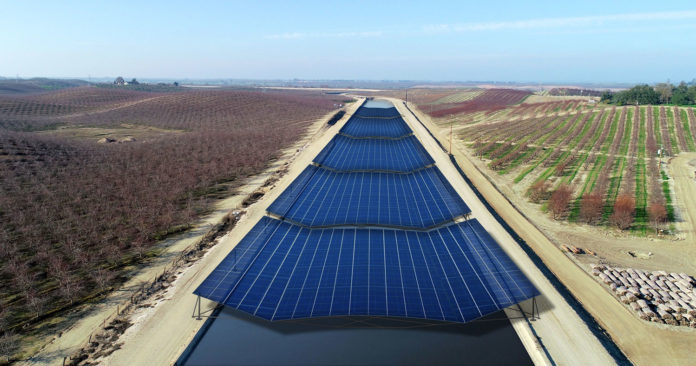Turlock Irrigation District (TID) has announced Project Nexus, a pilot project to build solar panel canopies over a portion of TID’s existing canals to operate and research how water-plus-energy can meet California’s needs for climate resiliency.
The Project Nexus could contribute to a more water resilient future for California and position the State to meet its ambitious clean energy goals. The Project will assess the reduction of water evaporation resulting from mid-day shade and wind mitigation; improvements to water quality through reduced vegetative growth; reduction in canal maintenance through reduced vegetative growth; and generation of renewable electricity.
The inspiration for Project Nexus comes from the concept presented in a recent study conducted by researchers at the University of California, Merced, and UC Santa Cruz, which found many advantages to mounting solar panels over open water canals. The study showed that covering the approximately 4,000 miles of California canals could save 63 billion gallons of water annually. This amount of water could be used to irrigate 50,000 acres of farmland or meet the residential water needs of more than 2 million people.
Putting solar panels on top of the canals could generate 13 gigawatts of energy each year, which is equal to about one-sixth of the State’s current installed capacity.
The TID is partnering with the Department of Water Resource (DWR), Solar AquaGrid, and the University of California, Merced, in the $20 million Project funded by the State of California. The groundbreaking on the project Nexus is scheduled for this fall, with project completion expected in 2024 at multiple locations throughout the TID service territory in California’s Central Valley. Energy storage will also be installed to study how storage facilities can support the local electric grid when solar generation is suboptimal due to cloud cover.
“The Solar AquaGrid model provides a combined, integrated response to addressing our water-energy nexus,” said UC Merced Professor Roger Bales. “It helps address California’s underlying vulnerabilities while meeting both state and federal level commitments to produce renewable energy, preserve natural lands, lower greenhouse gas emissions and mitigate climate change.”
